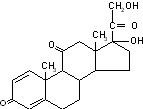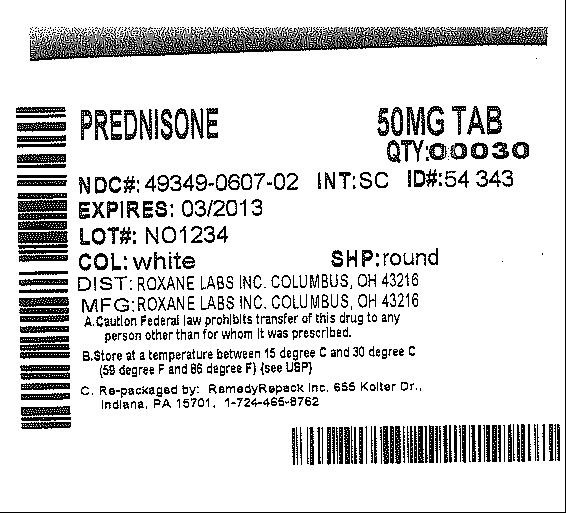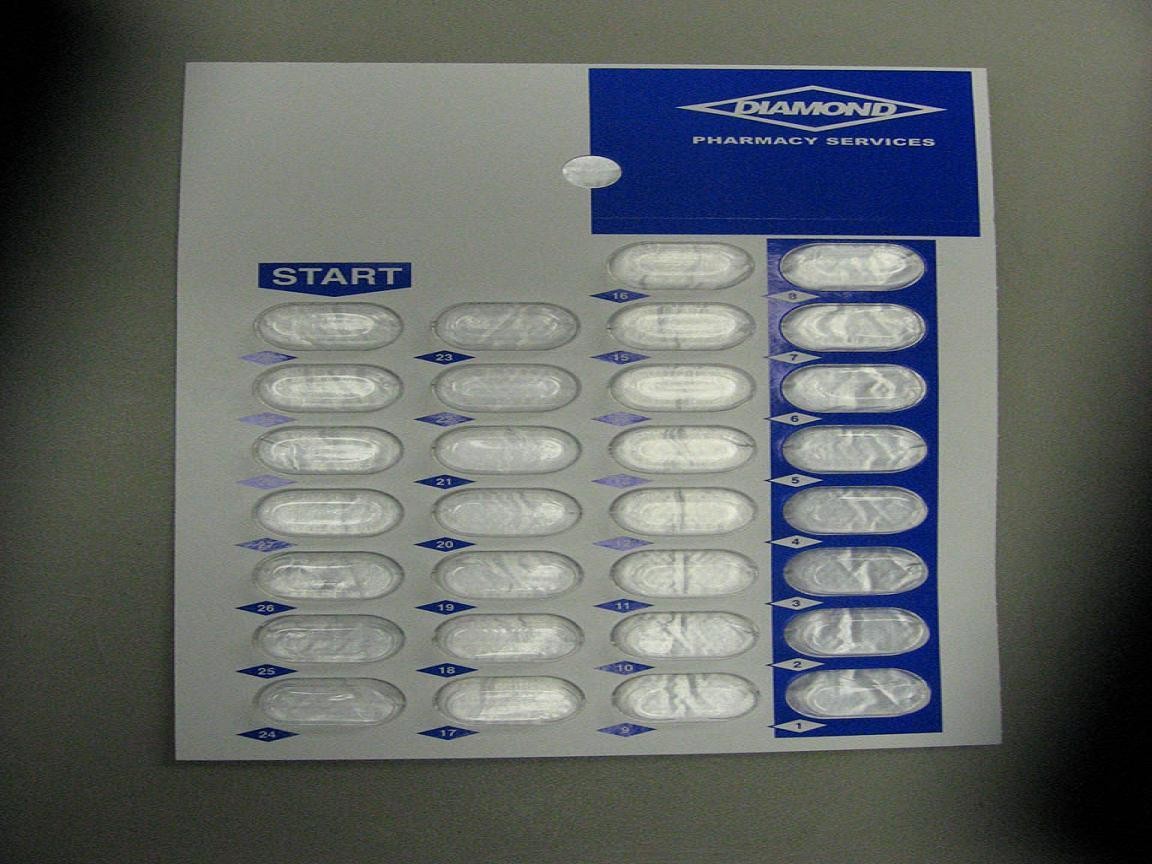Prednisone
FULL PRESCRIBING INFORMATION: CONTENTS*
- PREDNISONE DESCRIPTION
- CLINICAL PHARMACOLOGY
- INDICATIONS & USAGE
- PREDNISONE CONTRAINDICATIONS
- WARNINGS
- PRECAUTIONS
- INFORMATION FOR PATIENTS
- DRUG INTERACTIONS
- CARCINOGENESIS & MUTAGENESIS & IMPAIRMENT OF FERTILITY
- PREGNANCY
- NURSING MOTHERS
- PEDIATRIC USE
- GERIATRIC USE
- PREDNISONE ADVERSE REACTIONS
- DOSAGE & ADMINISTRATION
- HOW SUPPLIED
- STORAGE AND HANDLING
- REFERENCES
- PACKAGE LABEL.PRINCIPAL DISPLAY PANEL SECTION
FULL PRESCRIBING INFORMATION
PREDNISONE DESCRIPTION
Inactive Ingredients

CLINICAL PHARMACOLOGY
INDICATIONS & USAGE
Endocrine Disorders
Primary or secondary adrenocortical insufficiency (hydrocortisone or corisone is the first choice: synthetic analogs may be used in conjunction with mineralocorticoids where applicable; in infancy mineralocorticoid supplementation is of particular importance); congenital adrenal hyperplasia; hypercalcemia associated with cancer; nonsuppurative thyroiditis.
Rheumatic Disorders
Collagen Diseases
Dermatologic Diseases
Pemphigus; bullous dermatitis herpetuformis; severe erythema multiforme (Stevens-Johnson syndrome); exfoliative dermatitis; mycosis fungoides; severe psoriasis; severe seborrheic dermatitis.
Allergic States
Control of severe or incapacitating allergic conditions intractable to adequate trials of conventional treatment: seasonal or perennial allergic rhinitis; bronchial asthma; contact dermatitis; atopic dermatitis; serum sickness; drug hypersensitivity reactions.
Ophthalmic Diseases
Respiratory Diseases
Symptomatic sarcoidis; Loeffler's syndrome not manageable by other means; berylliosis; fulminating or disseminated pulmonary tuberculosis when used concurrently with appropriate antiuberculous chemotherapy; aspiration pneumonitis.
Hematologic Disorders
Idiopathic thrombocytopenic purpura in adults; secondary thrombocytopenia in adults; acquired (autoimmune) hemolytic anemia; erythroblastopenia (RBC anemia); congenital (erythroide) hypoplastic anemia.
Neoplastic Diseases
Edematous States
Gastrointestinal Diseases
Miscellaneous
Tuberculous meningitis with subarachnoid block or impending block when used concurrently with appropriate antituberculous chemotherapy; trichinosis with neurologic or myocardial involvement.\
PREDNISONE CONTRAINDICATIONS
WARNINGS
GeneralADVERSE REACTIONS:Allergic Reactions).
Cardio-Renal
Endocrine
Corticosteroids can produce reversible hypothalamic-pituitary adrenal (HPA) axis suppression with the potential corticosteroid insuffciency after withdrawal of treatment. Adrenocortical insuffciency may result from too rapid withdrawal of corticosteroids and may be minimized by gradual reducation of dosage. This type of relative insufficiency may persist for up to 12 months after discontinuation of therapy; therefore, in any situation of stress occurring during that period, hormone therapy should be reinstituted. If the patient is recieving steroids already, dosage may have to be increased.
Infection
PRECAUTIONS:Drug Interactions:Amphotericin B Injection and Potassium-Depleting Agents).
PRECAUTIONS
General PrecautionsCardio-Renal
Endocrine
Drug-induced secondary adrenocortical insufficiency may be minimized by gradual reduction of dosage. This type of relative insufficiency may persist for up to 12 months after discontinuation of therapy following large doses for prolonged periods; thereofre, in any situation of stree occurring during that period, hormone therapy should be reinstituted. Since mineralocorticoid secretion may be impaired, salt and/or a mineralocorticoid should be administered concurrently.
Gastrointestinal
Musculoskeletal
Neuro-Psychiatric
DOSAGE AND ADMINISTRATION:Multiple Sclerosis.)
Ophthalmic
INFORMATION FOR PATIENTS
DRUG INTERACTIONS
amphotericin B, diuretics), patients should be observed closely for development of hypokalemia. In addition, there have been cases reported in which concomitant use of amphotericin B and hydrocortisone was followed by cardiac enlargement and congestive heart failure.
PRECAUTIONS:Drug Interactions:Hepatic Enzyme Inducers, Inhibitors and Substrates).
neostigmine, pyridostigmine) and corticosteroids may produce severe weakness in patients with myasthenia gravis. If possible, anticholinesterase agents should be withdrawn at least 24 hours before initiating corticosteroid therapy. If concomitant therapy must occur, it should take place under close supervision and the need for respiratory support should be anticipated.
warfarin, although there have been some conflicting reports. Therefore, coagulation indices should be monitored frequently to maintain the desired anticoagulant effect.
isoniazidmay be decreased.
ciprofloxacin, levofloxacin) and corticosteroids, especially in the elderly. Tendon rupture can occur during or after treatment with quinolones.
inducecytochrome P450 3A4 (CYP 3A4) enzyme activity (e.g.,barbiturates, phenytoin, carbamazepine, rifampin) may enhance the metabolism of corticosteroids and require that the dosage of the corticosteroid be increased. Drugs whichinhibitCYP 3A4 (e.g.,ketoconazole, itraconazole, ritonavir, indinavir, macrolide antibiotics such as erythromycin) have the potential to result in increased plasma concentrations of corticosteroids. Glucocorticoids are moderate inducers of CYP 3A4. Co-administration with other drugs that are metabolized by CYP 3A4 (e.g.,indinavir, erythromycin) may increase their clearance, resulting in decreased plasma concentration.
aspirin(or othernonsteroidal anti-inflammatory agents
WARNINGS:Infection:Vaccination).
CARCINOGENESIS & MUTAGENESIS & IMPAIRMENT OF FERTILITY
PREGNANCY
NURSING MOTHERS
PEDIATRIC USE
ADVERSE REACTIONS). Like adults, pediatric patients should be carefully observed with frequent measurements of blood pressure, weight, height, intraocular pressure, and clinical evaluation for the presence of infection, psychosocial disturbances, thromboembolism, peptic ulcers, cataracts, and osteoporosis. Pediatric patients who are treated with corticosteroids by any route, including systemically administered corticosteroids, may experience a decrease in their growth velocity. This negative impact of corticosteroids on growth has been observed at low systemic doses and in the absence of laboratory evidence of hypothalamic-pituitary-adrenal (HPA) axis suppression (i.e., cosyntropin stimulation and basal cortisol plasma levels). Growth velocity may therefore be a more sensitive indicator of systemic corticosteroid exposure in pediatric patients than some commonly used tests of HPA axis function. The linear growth of pediatric patients treated with corticosteroids should be monitored, and the potential growth effects of prolonged treatment should be weighed against clinical benefits obtained and the availability of treatment alternatives. In order to minimize the potential growth effects of corticosteroids, pediatric patients should be titrated to the lowest effective dose.
GERIATRIC USE
PREDNISONE ADVERSE REACTIONS
Allergic Reactions
WARNINGS:Cardio-Renal), necrotizing angiitis, pulmonary edema, syncope, tachycardia, thromboembolism, thrombophlebitis, vasculitis.
PRECAUTIONS:General Precautions), lupus erythematosus-like lesions, perineal irritation, purpura, rash, striae, subcutaneous fat atrophy, suppression of reactions to skin tests, striae, telangiectasis, thin fragile skin, thinning scalp hair, urticaria.
WARNINGS:Endocrine), hypothyroidism, increased requirements for insulin or oral hypoglycemic agents in diabetics, lipids abnormal, moon face, negative nitrogen balance caused by protein catabolism, secondary adrenocortical and pituitary unresponsiveness (particularly in times of stress, as in trauma, surgery or illness) (seeWARNINGS:Endocrine), suppression of growth in pediatric patients.
PRECAUTIONS:Musculoskeletal), pathologic fracture of long bones, steroid myopathy, tendon rupture (particularly of the Achilles tendon), vertebral compression fractures.
PRECAUTIONS:Ophthalmic), optic nerve damage, papilledema.
WARNINGS:Infection), hiccups, immunosuppresion, increased or decreased motility and number of spermatozoa, malaise, insomnia, moon face, pyrexia.
DOSAGE & ADMINISTRATION
IT SHOULD BE EMPHASIZED THAT DOSAGE REQUIREMENTS ARE VARIABLE AND MUST BE INDIVIDUALIZED ON THE BASIS OF THE DISEASE UNDER TREATMENT AND THE RESPONSE OF THE PATIENT.After a favorable response is noted, the proper maintenance dosage should be determined by decreasing the initial drug dosage in small increments at appropriate time intervals until the lowest dosage which will maintain an adequate clinical response is reached. It should be kept in mind that constant monitoring is needed in regard to drug dosage. Included in the situations which may make dosage adjustments necessary are changes in clinical status secondary to remissions or exacerbations in the disease process, the patientcondition. If after long-term therapy the drug is to be stopped, it recommended that it be withdrawn gradually rather than abruptly.
Multiple Sclerosis
Alternate Day Therapy
HOW SUPPLIED
PredniSONE Tablets USP1 mg, round, white, scored tablets (Identified 54 092)
2.5 mg, round, white, scored tablets (Identified 54 339)
5 mg, round, white, scored tablets (Identified 54 612)
10 mg, round, white, scored tablets (Identified 54 899)
20 mg, round, white, scored tablets (Identified 54 760)
50 mg, round, white, scored tablets (Identified 54 343)
PredniSONE Oral Solution USP, 5 mg per 5 mL
Clear, colorless solution
PredniSONE IntensolOral Solution (Concentrate), 5 mg per mL
Clear, colorless, slightly viscous solution
STORAGE AND HANDLING
REFERENCES
PACKAGE LABEL.PRINCIPAL DISPLAY PANEL SECTION


PrednisonePREDNISONE TABLET
| ||||||||||||||||||||||||||||||||||||||||||||||||||||||||||||||||||||||||||||
PLEASE, BE CAREFUL!
Be sure to consult your doctor before taking any medication!